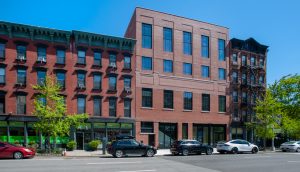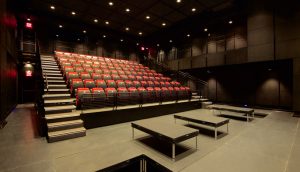A Sustainable Future for the Irish Arts Center
When New York City’s Irish Arts Center began its plans for a new building, inclusivity was always a goal.
“We had an opportunity to create a home for many different kinds of artists,” says Aidan Connolly, executive director of Irish Arts Center. “We wanted to project a dynamic image of Ireland and Irish America and how we’re engaging with other cultures to tell a broader story about our shared humanity.”
Achieving that vision included honoring and respecting the local community that embraced the Center for decades—including protecting the impact of the project on the neighborhood.

NO PLACE LIKE HOME
To start, the new Center is a new building occupying the lot of a former tire garage, Cybert Tire, adjacent to the 51st Street location the IAC has called home for 50 years. That design allowed the IAC to preserve and honor its place in the community as well as repurpose a former industrial site for a new use, including remediation of existing conditions common for an industrial site, such as contaminated soil. The state-of-the-art, flexible theater of the new Center also requires complex MEP systems, and the design team helped ensure those systems were as efficient as possible.
“The energy optimization on this project is a true testament to the design,” says Mark Hildreth, project manager for Pavarini McGovern, who is leading construction of the new IAC. “We did all we could to make sure those systems were properly coordinated to maximize efficiency while maintaining the critical acoustical requirements.”
With a relatively tight site to house the Center’s ambitions and the intricate MEP systems, Hildreth and his team hosted extra coordination meetings with the designers, using 3D modeling to hone the coordination process and spending additional time together scrutinizing the details during preconstruction.
The Pavarini McGovern team also built in the responsibilities of proper construction waste management, recycling, regional material sourcing, and other sustainable processes to work toward the project’s LEED Silver target. “As anyone who works in New York City knows, construction recycling requirements have an added complexity due to the lack of space,” says Hildreth. “We utilized off-site comingled material sorting to reduce the footprint on-site and still meet the project’s recycling goals.”

READY FOR ACTION
While COVID did pause the progress of the new Center during the city’s mandatory shutdowns, the project was granted permission to complete the unfinished exterior. The PMG team took quick measures to enclose the building before the shutdowns to avoid any damage.
“The timing was difficult as we were only a few weeks out from installing the curtainwall and completing the roof to fully enclose the building,” says Hildreth. “Once the state issued the pause executive order, our team moved quickly to provide temporary enclosures to safe-off the building from the elements and were then able to pick up right where we left off once work was permitted to resume. Fortunately, were able to protect the building from serious damage and minimize exposure to the project.”
The new Irish Arts Center has received its TCO (temporary certificate of occupancy) and the team has begun to outfit the building’s technical capability as final construction details are completed. The entire team has its eye on the prize—resuming live performances, classes, and activities in the new theater, studios, classrooms, exhibit areas, and café. “We can’t wait for everyone to get to experience it,” says Hildreth.
